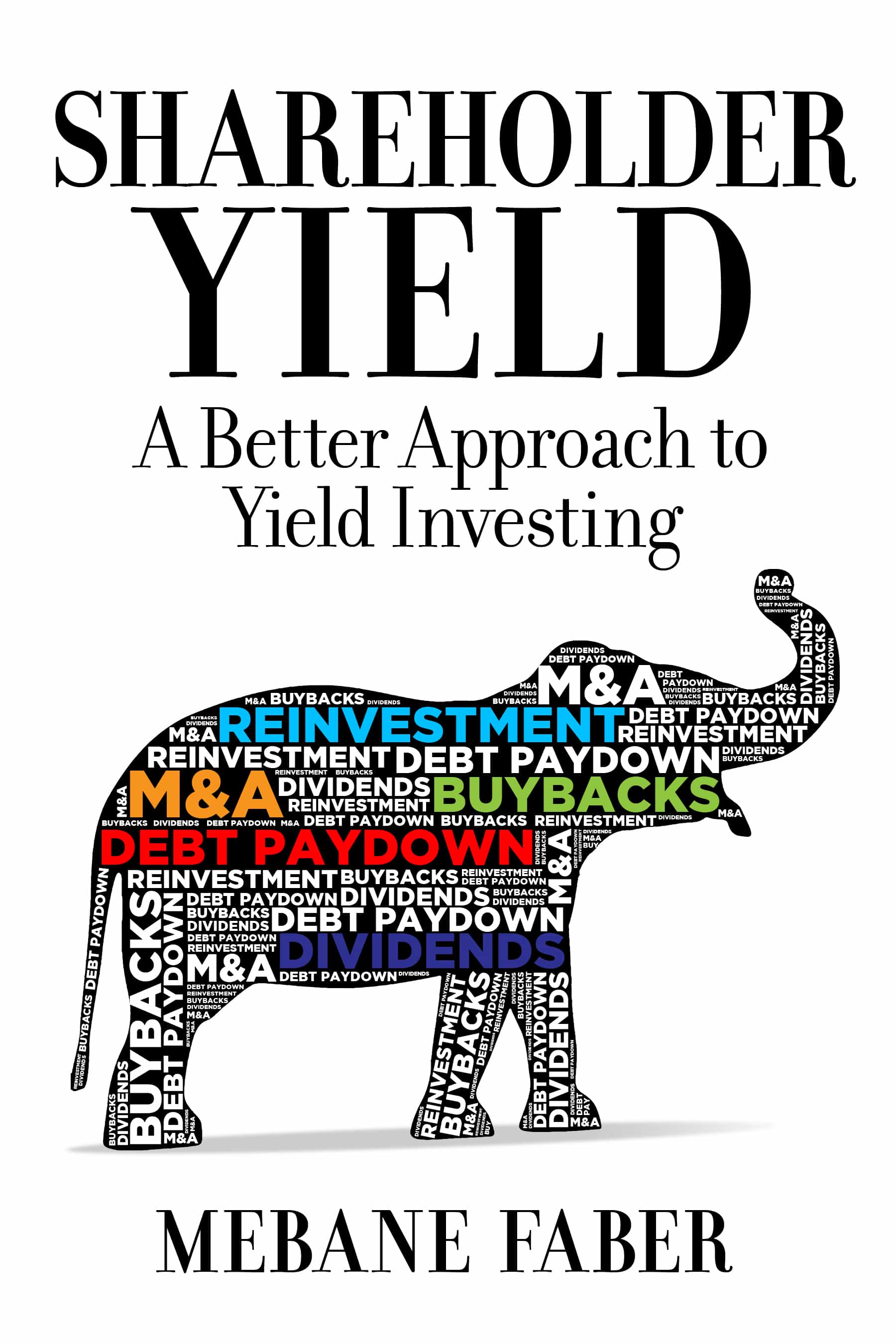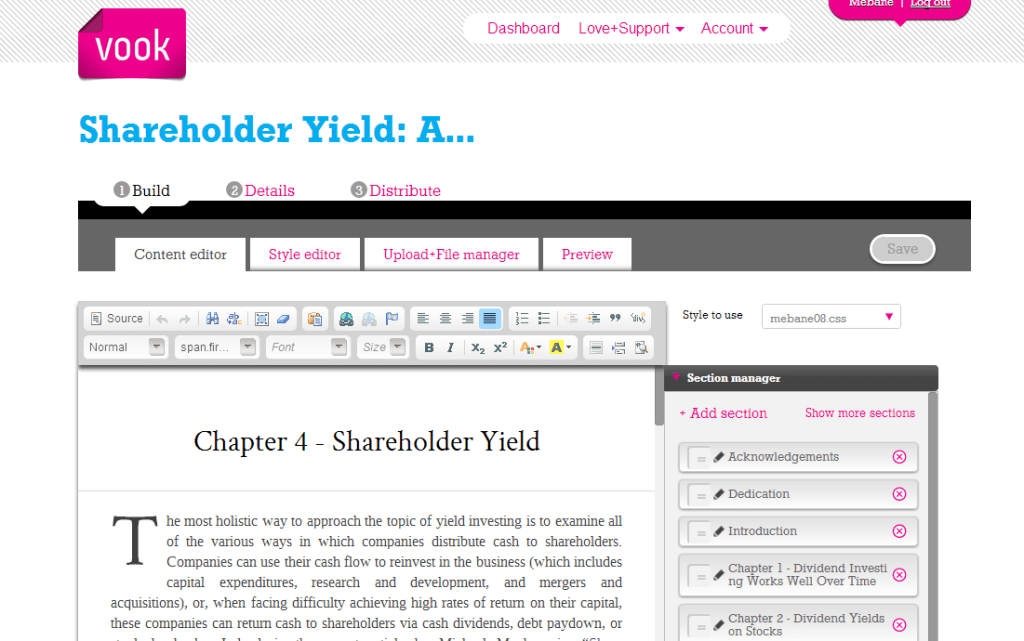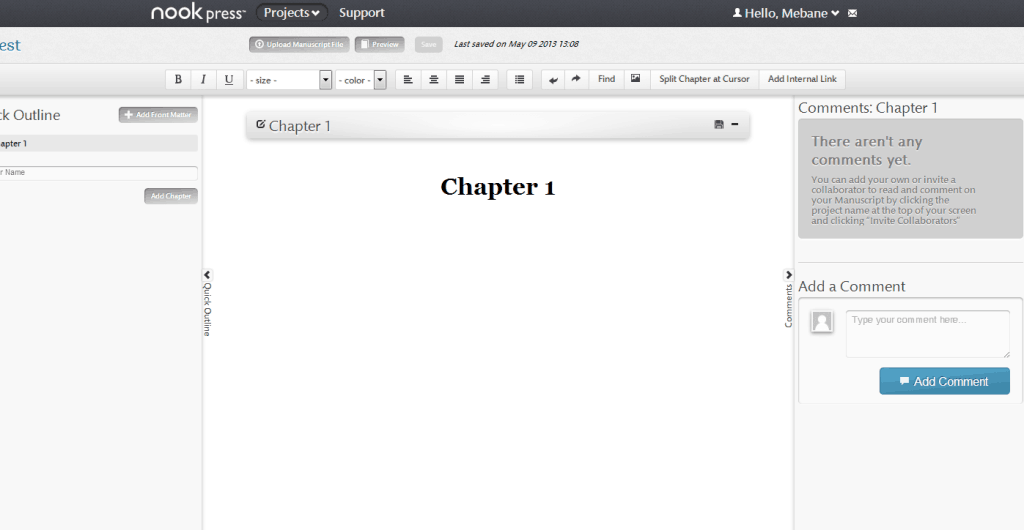Below is a summary of my views on self publishing my first book, which you can find on Amazon here – Shareholder Yield: A Better Approach to Dividend Investing. This post will be updated periodically with my thoughts on the experience…
I thought I would summarize some of my experiences with self-publishing an eBook as I get a lot of emails from readers inquiring about the process. After publication I’ll update this every quarter or so with sales numbers and other thoughts on the experience to try and bring a little transparency to this somewhat murky world of publishing. My friend James has written a lot of great material on the subject so you can find some background here and here. Patrick Wensink also has a humorous piece on his best seller, and the amount of money he made from it…
We have been waiting to publish this short ebook for about a year and a half but had to wait due to the timing of my company getting exemption to launch ETFs with the SEC. It is shorter than our last book (60 pages or so I believe), but I see no reason for a book to be long just for the sake of being long. Actually, most books I read in finance could should be about 20 pages or so instead of 300.
BACKGROUND
For those new to the blog here is a little context as to how I came to self-publish a book. I started (reluctantly) publicly writing about six years ago with an academic paper and this blog which has now passed over 1,300 articles. I’ve also written for a few websites (fired by one), and published some more academic papers, magazine articles, videos, and a book at the beginning of 2009 so I have gained a pretty broad overview of the various outlets to publishing in the investing space.
My first publisher was Wiley, one of the most prolific publishers in our field. My first book was They Ivy Portfolio, which probably should have been three separate books, but being a first time author I wanted to try and get in as many of my views and beliefs across as possible. Wiley receives the lion’s share (85% or so) of the profits. For a $50 book, we would end up getting about $3-4 per copy. Granted, Amazon et al immediately discount the book to about $30 from the $50 price tag. I liked my editor and everyone there, but from a business standpoint I don’t think that arrangement makes a lot of sense.
However, nothing beats the feeling of seeing your book in the window of a bookstore, or having someone email you from Brazil to say they saw it, or see it translated into Chinese, or the ability to send it to someone in the mail, etc. It is hard to get past the romance of writing a physical book, and possibly I’ll go back to it after this experiment…It was a good experience for the first book, and I learned a lot.
However, I always recommend to first time writers to go the traditional route – at the very least you will learn a great deal. We used to joke any future books would be “100 Things Not To Do When Writing A Book”.
PURPOSE
Lots of writers depend on their writing for their livelihood, and profiting from their publications is a high priority. For many in my field of money management, it is more of a distribution tool to circulate your views or research, and profiting from a book is much lower on the list. My partner and I have a lot of debates here, as he thinks not doing a hard copy is a mistake (an argument which I don’t disagree with). All I really care about is as many people reading the work as possible, and it seems the world is quickly moving to i-everything, although I think I am the only holdout in the world that still reads mainly physical books. I hate reading electronic books but I think I’m the rare exception.
FORMATTING
“The charts and tables in the Kindle edition are virtually unreadable, either on the Kindle itself or on a computer using the Kindle app.” That was a recent Amazon reviewer comment on my last book. I almost had a heart attack noticing the errors in my first book, and I can barely pick up the hard copy without the nails on the chalkboard feeling of seeing them in print and especially in digital format.
For this reason I wanted software that would be able to let you preview the copy, so we’re trying Vook as it looks like it is fully capable of that and I will report back. They seem to be transitioning their business model to an outsourced platform (which is a good idea), and everything on their site is easy to use ala WordPress. By far the best part is that you can preview your book on any device, which was huge for me.
I’m not altogether certain why Amazon doesn’t buy/build a much better platform for uploading your own content but I would expect that to change in the future. Absurd really. Barnes and Noble has this feature, and you can see screenshots from Nook and Vook below.
EDITING
In general, since I no longer had an editor ala Wiley, I relied on friends and family as well as a cool website called Kibin. Jacqueline at the Reality Test was a fantastic writer/editor as well.
AGENT
You don’t really need one if you’re doing it on your own, but they can be priceless when negotiating with the publishing companies.
COVER DESIGN
We did a simple cover design contest on 99 Designs. If you have a vauge idea of what you want, and are willing to invest some time in feedback you can come up with some pretty killer designs. Obviously, the more you spend the higher quantity and quality of submissions, but for $500 we got about 100 cover ideas. The winner is our current cover. (And if you like our cover you can contact the designer directly here: designer@adibustamandesign.com and view his work at http://adibustamandesign.com/category/my-portfolio/ .)
You can also get a discount on 99Designs if you are a FoundersCard member.
TITLE
I don’t pretend to have any marketing ability, so we played around with some subtitles for Shareholder Yield. One of the ideas ala Tim Ferris is to setup a Google Adwords campaign with the potential titles and test to see what titles get the most click-throughs. The challenge here is that the results will be just that, where the more outlandish or click bait the headline is the more click-throughs you get. The winning title (which we are not using since I think it is snake oily) was “If You’re Investing in Dividends, You’re Doing it Wrong!”. Ha.
We settled on “A Better Approach to Dividend Investing”.
PRICE
The 10 or so papers (and over 1,300) blog posts have been free to download and read. However, I like Amazon as a great distribution method for all the folks that like reading on their Kindle and iPad. My first book cost $50! retail, although Amazon immediately discounts that to around $32, and now the kindle and paperback are about $10. I would be happy charging as little as possible ($1), or possibly even the Radiohead model (pay what you want), but my partner brought up the perceived value question. Will people that do not know me as a writer perceive a $1 book to be of poor quality? In the end we settled on $4.99 as a reasonable alternative, or the same cost as a large latte from Starbucks.
DISTRIBUTION
Once you get past the romance of seeing your book in bookstores and airports, distribution doesn’t matter since you can upload your eBook to any of the online platforms (most sales will be Amazon, but also iTunes and B&N). Many money management companies use a different model where the content is free, but you have to give up your contact information (ala Fisher).
If you decide to go the Amazon route, they actually have a program that lets prime readers download the book for free one week per quarter (and the writer still gets part of a pool of $ AMZN has set aside). Although you agree to be exclusive to Amazon for 90 days. They also allow you to designate a 5 day period per quarter where people can download your book for free, but you get no royalties. Not sure if the Prime download outweighs not being on Apple and Barnes and Noble. We are going to upload the book to Apple and Barnes and Noble to test to see if they generate many sales (apparently it takes awhile to get vendor approval). If they don’t I’ll move to the Amazon KDP Select program to try it out.
MARKETING
My experience with the traditional publishing route didn’t leave me feeling the publishing company offered a whole on the marketing side, which seems to be confirmed with most of my author friends. For many authors your brand and audience is the #1 asset you have. Lots and lots of ideas over at Tim Ferris’s (who is self publishing and also promoting via BitTorrent) site. Most important is that you put our a quality book that people want to read.
While most of the sales will be from your own brand, hiring a decent PR firm doesn’t hurt if you want the exposure. We like the Dukas crew in NYC to help get the word out, but nothing beats having an audience that is willing to spread the word.
WEBSITE
I am surprised most books don’t have a simple landing page for readers, especially if the author doesn’t already have a blog. We have used Morningtide Design for all of our design work, and you can see their capabilities on Cambria Investment Management, The Idea Farm, and of course on this blog.
REVIEWS
I often wake up to a bunch of emails from readers (more when something new comes out) asking questions about various articles or research pieces/book we have written. I strive really, really hard to answer every email I receive, which is incredibly time consuming. One idea I think is reasonable is to request the favor of writing a review for spending the time to take the time to personally answer all their questions (good or bad, 1-5 stars doesn’t matter). Many are happy to do so.
Invariably you will get bad reviews, and the worst is bad reviews from people that never bothered to read the book and give 1 stars for shipping or formatting… So it goes.
SALES
I’ll update this every quarter or so once they come in.
And to close out this blog piece, one last question:
“What do you wish you’d known about the process of writing a book that you didn’t know before you did it?”
Here is a fun article for my writer friends that looks at advice from 23 published authors on the process of writing a book. Some cool advice:
Be ready to organize vast amounts of data. Use a wall, or software like Scrivener. – Carl Zimmer
Make it great, no matter how long it takes. There’s no such thing as too many drafts. There’s no such thing as too much time spent. As you well know, a great book can last forever. A great book can change a person’s life. A mediocre book is just commerce…..Let some of you come through. You’re obviously not writing a memoir here, but this book is still partly about you — the world you see, the way you think, the experiences you have with people. And trust me, readers are interested in who you are. So don’t be afraid to let bits and pieces of your personality and even life details seep into the text. It will breathe a lot of life into the book. –David Shenk
Write when the book sucks and it isn’t going anywhere. Just keep writing. It doesn’t suck. Your conscious is having a panic attack because it doesn’t believe your subconscious knows what it’s doing. – Cory Doctorow
And run all quirky one-liners that you hope to include in your author’s bio (do you “always enjoy a good latté”?) past a close friend; they don’t age well. –Geoff Manaugh
Don’t forget to write the book that you want to read. – Mark Frauenfelder
When my self-disgust reaches critical mass I seem to be ready to go. –August Kleinzahler
Develop a very serious plan for dealing with internet distractions. I use an app called Self-Control on my Mac. –Ben Casnocha
How inept publishers are at selling books, even books that, as in my case, they have a significant financial stake in and that they profess to love. Once they get rejected by Today and Terry Gross and once the SundayTimes passes (or, as in my case, assigns a review and then never runs it), they’ve exhausted their playbook. Solution: what you’re already doing, which is to build your brand among your intended audience. – Anon
The most striking thing about my book processes was that no one at the publisher did any editing at all. No fact checking, no line editing. – David Gans
Apply to MacDowell, Yaddo, Blue Mountain Center, Headlands — a few other good residencies, including one in Cali I can’t remember now. Four to eight weeks of you, quiet, among other artists, with people feeding you on schedule can do wonders. –Josh Shenk
Hat tip Kottke.




